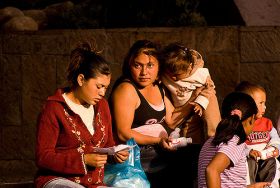How are women and girls treated in San Miguel de Allende?
Mary Agnes McKay
 In San Miguel de Allende, Mexican women have traditionally been, and still to a great extent still are, relegated to second-class status. That’s not to say that the brains behind the operation in the home is not the woman, but in public, it’s very important that the woman walk behind her husband, and that she not answer if they’re asked a question together in a group setting. He’s the leader. He’s in charge. Mexican women seem to have accepted this and...
In San Miguel de Allende, Mexican women have traditionally been, and still to a great extent still are, relegated to second-class status. That’s not to say that the brains behind the operation in the home is not the woman, but in public, it’s very important that the woman walk behind her husband, and that she not answer if they’re asked a question together in a group setting. He’s the leader. He’s in charge. Mexican women seem to have accepted this and... In San Miguel de Allende, Mexican women have traditionally been, and still to a great extent still are, relegated to second-class status. That’s not to say that the brains behind the operation in the home is not the woman, but in public, it’s very important that the woman walk behind her husband, and that she not answer if they’re asked a question together in a group setting. He’s the leader. He’s in charge. Mexican women seem to have accepted this and it’s just the role they fill without great stress, anger, or frustration.
In San Miguel de Allende, Mexican women have traditionally been, and still to a great extent still are, relegated to second-class status. That’s not to say that the brains behind the operation in the home is not the woman, but in public, it’s very important that the woman walk behind her husband, and that she not answer if they’re asked a question together in a group setting. He’s the leader. He’s in charge. Mexican women seem to have accepted this and it’s just the role they fill without great stress, anger, or frustration. How they treat women in San Miguel de Allende is getting better somewhat in the much younger generation, amongst the more educated and those with more material success. When you see Mexican families at dinner, this is where I notice it most. For example, in a restaurant, I usually meet middle class Mexican women. If they can afford to eat out at a restaurant, then they probably have a somewhat good job and an education- at least high school. But once you get below that level, for example, in the rural areas of San Miguel de Allende, where I spend a good amount of time, I do not see a change.
Another problem that Mexican women have with how they’re treated in San Miguel de Allende has to do with being left alone and becoming a single parent. Traditionally, there was always a marriage associated with a child, but that has changed in recent years. The women get married, have three to seven children, then the husband decides he doesn’t want that anymore and just leaves the woman. That may not be totally unlike in the States, but here in San Miguel de Allende, it’s rare that there is a formal separation agreement, or that there’s a formal divorce, so there is no support paid by the husband. The man simply leaves the woman who has, for example, five children, but with no way to support them because traditionally, she has stayed at home to raise them.
One solution to the problem of being left by the husband is that the woman can remarry, but that is very, very rare because a Mexican man does not want, and will not accept, for the most part, the children of another man, so the deck is stacked against the woman remarrying.
Here in San Miguel de Allende, because of the expat population, there are efforts and organizations that reach out to high school females to encourage them to stay in school and to provide high school and college scholarships for them. This is rare in other parts of Mexico, but it’s because of the nature of San Miguel de Allende in particular. In the smaller communities, you wouldn’t see that at all; the young girls just accept their role and situation the same way their mother had.
As far as the treatment I’ve received here in San Miguel de Allende, I have always been treated with respect. Whether it’s a taxi driver, someone on the street in town, or any of the workers. Here in San Miguel de Allende, people know that if they overstep their bounds, they lose their job, which is a great job to have.
I have a friend who is much younger than I. She’s from Oregon, and she’s blonde. She once told me that since she lives in a small Mexican community outside of Centro in San Miguel de Allende and is surrounded by Mexicans, when she walks down the street, if there are groups of young Mexican men together, she’ll get whistles from these men. She has discovered that the best way to counteract the whistles is to look right at them, and say “Buenos dias,” or “Buenos tardes,” and to call them either “neighbor” or “son,” because they would never think of doing anything negative to a mother. So my friend typically says, “Buenos tardes, ninos!” and that ends it there.
(Mother and children in San Miguel de Allende, Mexico, pictured.)
Posted December 4, 2016
Nancy Howze - CDR Bienes Raices San Miguel, SC
 I moved to San Miguel de Allende as a young single woman, and I have found San Miguel de Allende to be a great women’s town. There are a lot of women here in San Miguel de Allende who have been here for a long time. A lot of single women own homes in San Miguel de Allende, while some women here come and go. A lot of women meet their husbands here in San Miguel de Allende, and then come frequently without their husbands to hang around town.
I moved to San Miguel de Allende as a young single woman, and I have found San Miguel de Allende to be a great women’s town. There are a lot of women here in San Miguel de Allende who have been here for a long time. A lot of single women own homes in San Miguel de Allende, while some women here come and go. A lot of women meet their husbands here in San Miguel de Allende, and then come frequently without their husbands to hang around town. San...
 I moved to San Miguel de Allende as a young single woman, and I have found San Miguel de Allende to be a great women’s town. There are a lot of women here in San Miguel de Allende who have been here for a long time. A lot of single women own homes in San Miguel de Allende, while some women here come and go. A lot of women meet their husbands here in San Miguel de Allende, and then come frequently without their husbands to hang around town.
I moved to San Miguel de Allende as a young single woman, and I have found San Miguel de Allende to be a great women’s town. There are a lot of women here in San Miguel de Allende who have been here for a long time. A lot of single women own homes in San Miguel de Allende, while some women here come and go. A lot of women meet their husbands here in San Miguel de Allende, and then come frequently without their husbands to hang around town. San Miguel de Allende an easy town to get around in, and it’s safe. Most people, women included, feel very comfortable here in San Miguel de Allende.
(Nancy Howze with CDR Bienes Races San Miguel realtors, San Miguel de Allende, Mexico, pictured.)
Posted December 22, 2016
Ariadna Delsol - COLONIAL REAL ESTATE
 Women and girls are well-treated in San Miguel de Allende and there is no reason for them to be treated badly. Mexico is pretty much the same as the US; there is no difference whatsoever.
Women and girls are well-treated in San Miguel de Allende and there is no reason for them to be treated badly. Mexico is pretty much the same as the US; there is no difference whatsoever. I have lived in France, Australia, on the East Coast and the West Coast in the US. I lived on the West Coast for almost 10 years and I see no difference in how women and girls are treated in Mexico and in Monterrey, where I used to live.
The...
 Women and girls are well-treated in San Miguel de Allende and there is no reason for them to be treated badly. Mexico is pretty much the same as the US; there is no difference whatsoever.
Women and girls are well-treated in San Miguel de Allende and there is no reason for them to be treated badly. Mexico is pretty much the same as the US; there is no difference whatsoever. I have lived in France, Australia, on the East Coast and the West Coast in the US. I lived on the West Coast for almost 10 years and I see no difference in how women and girls are treated in Mexico and in Monterrey, where I used to live.
The difference would depend on the family. There are women who get beaten in the States, just as there are women who get beaten anywhere in the world. It is just a matter of social level, education and how you allow yourself to be treated as a woman. Here in Mexico, there are opportunities for women in business, politics, and everything else, just like there is in the US.
(The realtors at Colonial Real Estate, San Miguel de Allende, Mexico, pictured.)
Posted January 14, 2017


